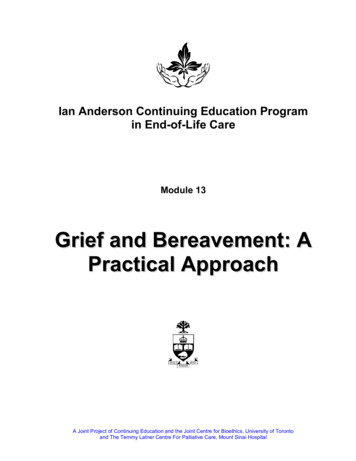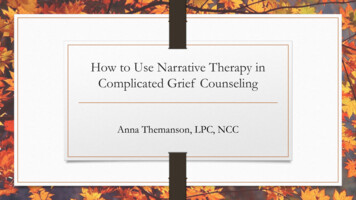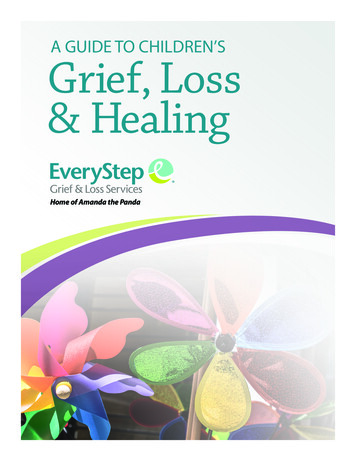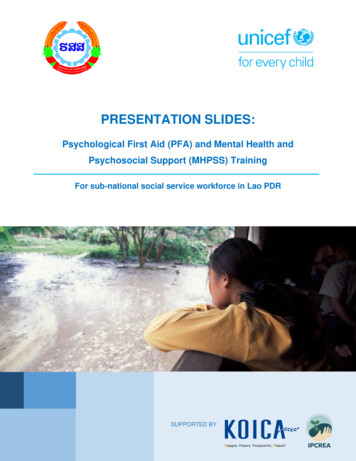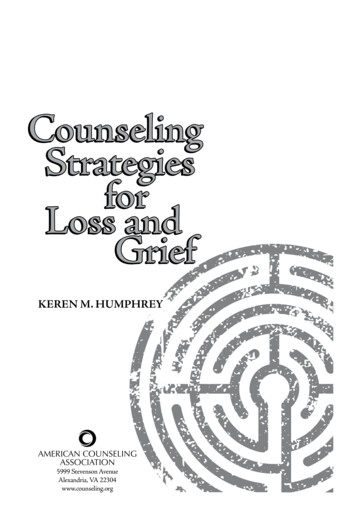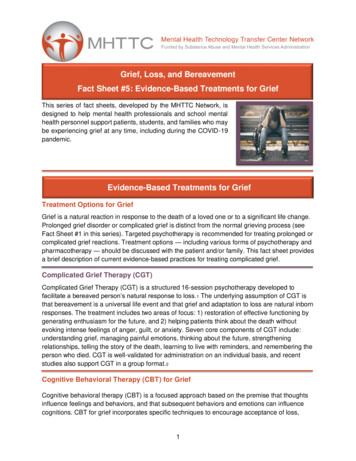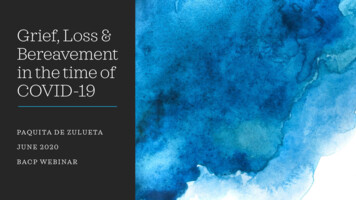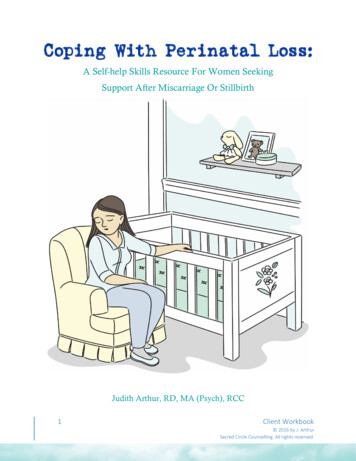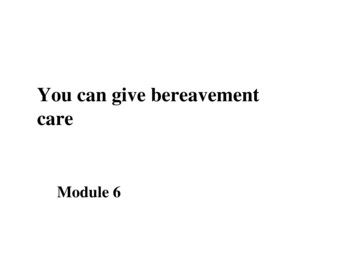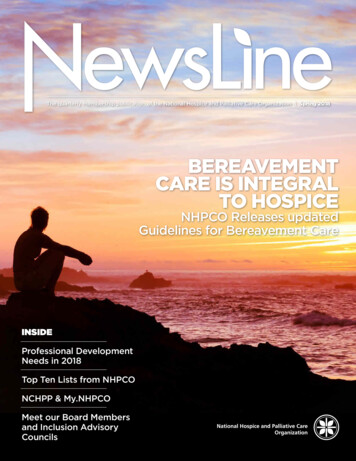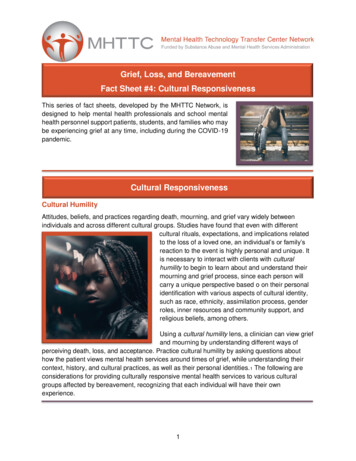
Transcription
Grief, Loss, and BereavementFact Sheet #4: Cultural ResponsivenessThis series of fact sheets, developed by the MHTTC Network, isdesigned to help mental health professionals and school mentalhealth personnel support patients, students, and families who maybe experiencing grief at any time, including during the COVID-19pandemic.Cultural ResponsivenessCultural HumilityAttitudes, beliefs, and practices regarding death, mourning, and grief vary widely betweenindividuals and across different cultural groups. Studies have found that even with differentcultural rituals, expectations, and implications relatedto the loss of a loved one, an individual’s or family’sreaction to the event is highly personal and unique. Itis necessary to interact with clients with culturalhumility to begin to learn about and understand theirmourning and grief process, since each person willcarry a unique perspective based o on their personalidentification with various aspects of cultural identity,such as race, ethnicity, assimilation process, genderroles, inner resources and community support, andreligious beliefs, among others.Using a cultural humility lens, a clinician can view griefand mourning by understanding different ways ofperceiving death, loss, and acceptance. Practice cultural humility by asking questions abouthow the patient views mental health services around times of grief, while understanding theircontext, history, and cultural practices, as well as their personal identities. 1 The following areconsiderations for providing culturally responsive mental health services to various culturalgroups affected by bereavement, recognizing that each individual will have their ownexperience.1
African American Expressions of GriefA unique history of poverty, racism, and oppression has placed untold stresses on AfricanAmericans that may contribute to a distinct grieving process within this cultural group. Commonthemes when working with African American clients affected by grief include: Within the African American community, problems may be dealt with informally orindirectly, or in some cases with no action being taken.2 The tendency to talk less withothers about their loss or seek professional support may place African Americans athigher risk for developing complicatedgrief symptoms.African Americans report a highdegree of religious participation,religious coping, and spirituality. Thegrief process may involve an ongoingspiritual connection with the deceasedthat must be honored and respected.Treatment providers may considerinvolving African American clergy intreatment programs to improve clergymembers' understanding of thegrieving process and to better engage patients and their families.A reluctance to use health services, including mental healthcare, may be present insome African American communities, as a result of mistrust of medical care and acultural bias against services that are perceived to be discriminatory. African Americanclients are likely to benefit from orienting sessions that review treatment and counselingprocesses, reassure confidentiality, and discuss treatment goals and other componentsof services.Hispanic and Latino/a/x Expressions of GriefAmong Hispanic and Latino/a/x individuals living in the United States are people from variouscountries in North, Central, and South America who each represent unique values and customs.Because there is no single “Latino/a/x culture,” practices related to grief and bereavement vary.Despite the many variations, some similarities can be identified as references to work effectivelywith the Hispanic population: Hispanic and Latino/a/x families may seek help initially from health care providers forsomatic symptoms, rather than mental health providers for symptoms of grief.3Stigma related to mental health disorders and mental health treatment may preventLatinos from seeking services.2
Recognizing and incorporating cultural values and rituals as important elements in griefprocesses will promote engagement, trust (confianza), and, thus, adherence totreatment. Hispanic and Latino/a/x culturesplace a strong emphasis on theimportance of family as a primarysystem of support, and there is astrict family hierarchy (usually older toyounger). This cultural value is knownas familismo. Individuals of HispanicLatino descent expect health careproviders to engage surviving familymembers in the therapeutic process. Many Hispanic and Latino/a/xindividuals embrace religion and spirituality at the core of their lives, as well as a belief inthe spiritual and psychological continuity between the living and the dead. As part oftheir spiritual practices, the familymay continue a relationship with thedeceased person through prayer,ritual, and traditional practices.Personalismo, or the importance ofcultivating a warm and caringrelationship, is a significant culturalvalue for many Hispanic andLatino/a/x families. Hispanic familiesneed to feel connected to and trusttheir therapist in order to fully engagein treatment.Asian American and Pacific Islander Expressions of GriefThe Asian American/Pacific Islander culturalgroup encompasses a heterogenous culturalgroup. Because expressions of grief andbereavement are affected by cultural,generational and acculturation levels,treatment providers must assess thesespecific cultural factors when working with thispopulation. For many Asian-American/Pacific Islandercultures, restraint in expressing negative3
feelings is valuable in maintaining self-esteem and interpersonal harmony. As a result,Asian American individuals may report somatic or physical manifestations of grief, asthey are viewed as more acceptable than psychological symptoms. Treatment providersshould be aware of their clients' cultural beliefs related to psychological distress and howthey may influence their grief symptoms.4Asian American clients may look tocounselors for expertise. AsianAmerican clients may expect and bemost comfortable with formalism onthe part of counselors, especially atthe beginning of treatment and priorto assessment of clients' needs.Indigenous healing has long been apractice of many Asian-Americansand Pacific Islanders.Religion/spirituality, community, andfamily may also be seen asprotective factors for bereaved Asian-Americans and Pacific Islanders.Native American and Alaska Native or Indigenous Peoples’ Expressions of GriefNative American and Alaska Native (AI/AN) or Indigenous Peoples’ beliefs about death anddying can differ across Tribal groups. There are, however, commonalities that differentiateIndigenous bereavement practices from mainstream culture in the United States. In many Native American family systems,everyone is involved during times of death,and extended family may travel greatdistances to provide support. Extended familymembers are often involved in decisionmaking surrounding burial and mourning, andcounselors can consider including them in thecounseling process.5 Receiving non-Native professionalassistance in the dying and grieving processhas traditionally been avoided, but isbecoming more commonly accepted. Ceremonies and burials are often private. It isimportant for practitioners to understand that it is best to work with all clients, includingIndigenous participants, on their terms, and consider both individual and familyinterventions.For many Native Americans, grief and mourning are generally seen as necessary andnatural. However, there exist some gender differences in grief expression shaped by4
communal expectations. For example, in some communities, men may express minimalemotion publicly, while women may express their emotions more openly.SummaryThe COVID-19 pandemic has created a newreality marked by grief and loss. While illness,death, and dying are universal experiences, theways in which our clients respond to them areshaped by their individual cultural identities. It isthe responsibility of the provider to learn howthe cultural backgrounds of their clientsinfluence their beliefs about death andmourning. By approaching grief with culturalhumility, providers can more compassionatelyand effectively support clients in their individualexpressions of loss.ResourcesGrief Speaks: Cultures and GriefNational Hispanic and Latino MHTTC: Communicating Death and Dying to Latino Families during aPandemicNational Hispanic and Latino MHTTC: Complicated Grief: Cultural Considerations When Working withLoss in Hispanic and Latino Students and Their FamiliesPacific Southwest MHTTC: Building Skills for Cross-Cultural Communication and Resilience DuringCOVID-19Pacific Southwest MHTTC: COVID-19 and Mental Health Resources: For Diverse Populations andProviders Who Support ThemQuality Interactions: Cultural Competency and COVID-19 [Infographic]South Southwest MHTTC: Cultural and Linguistic Responsiveness in Telehealth Mental HealthTechnology Transfer CenterUniversity of Montana Institute of Health and Humanities: Cross-Cultural Perspectives on Death, Dying &GriefPlease visit the MHTTC COVID-19 Grief, Loss and Bereavement Webpage for additionalresources, webinars, and training toolkits.DisclaimerThis presentation was prepared for the Mental Health Technology Transfer Center (MHTTC) Network under a cooperative agreement from the SubstanceAbuse and Mental Health Services Administration (SAMHSA). All material appearing in this presentation, except t hat taken directly from copyrighted sources,is in the public domain and may be reproduced or copied without permission from SAMHSA or the authors. Citation of the source is appreciated. Do notreproduce or distribute this presentation for a fee without specific, written authorization from the MHTTC Network. For more information on obtaining copiesof this presentation, please email NETWORKOFFICE@MHTTCNETWORK.ORG. The opinions expressed herein are the views of the presenters and do notreflect the official position of the Department of Health and Human Services (DHHS) or SAMHSA. No official support or endorsement of DHHS or SAMHS Afor the opinions described in this presentation is intended or should be inferred.5
References1.2.3.4.5.Hook, J. N., Davis, D. E., Owen, J., Worthington, E. L., Jr., & Utsey, S. O. (2013). Cultural humility: Measuringopenness to culturally diverse clients. Journal of Counseling Psychology, 60(3), 353-366. doi:https://doi.org/10.1037/a0032595Laurie, A. & Neimeyer, R. A. (2008). African Americans in bereavement: Grief as a function of ethnicity. Journal ofDeath and Dying, 57, 173-193. doi: https://doi.org/10.2190/OM.57.2.dVasquez, C. O. & Rosa, D. (2011) Grieving and Health. In: Grief Therapy with Latinos: Integrating Culture forClinicians. (pp., 203-233). Springer.Iwamassa, G. Y. Recommendations for the treatment of Asian American/Pacific Islander populations. In:Psychological Treatment of Ethnic Minority Populations (pp. 8-12). Council of National Psychological Associations forthe Advancement of Ethnic Minority Issues.Sharp, C., Beckstein, A., Limb, G., Bullock, Z. (2015). Completing the circle of life: Death and grief among NativeAmericans. In J. Cacciatore, J. & J. DeFrain (Eds.), The World of Bereavement. (pp. 221-239) Spinger.Authors:Andrea G. Alioto, PhD, LPMindy Chadwell, PhD, LP, BCBAAri Acosta, Psy & MSc. WGSJennifer Baran-Prall, LCSWSean Bear, BA (Meskwaki)Teresa Brewington, MBA, MEDL(Coharie and Lumbee)Ricardo Canelo, BAÁngel D. S. Casillas Carmona, MHSRay Daw, MA, Diné (Navajo)Heather Gotham, PhDMatt Ignacio, PhD, MSSW (TohonoO’odham)Louis Kurtz, MedDarice Orobitg, PhDKatty Rivera, MEdPJ Wenger, LPC, MFT, NCCLeora Wolf-Prusan, EdDMHTTC Network Coordinating OfficeMid-America MHTTCSouth Southwest MHTTCSouth Southwest MHTTCUniversity of Iowa Native Center for Behavioral HealthNational American Indian and Alaska Native MHTTCMHTTC Network Coordinating OfficeNational Hispanic and Latino MHTTCNational American Indian and Alaska Native PTTCMHTTC Network Coordinating OfficeUniversity of ArizonaGreat Lakes MHTTCNational Hispanic and Latino MHTTCNortheast and Caribbean MHTTCNortheast and Caribbean MHTTCPacific Southwest MHTTC, School Mental Health Lead6September 2020
Grief, Loss, and Bereavement Fact Sheet #4: Cultural Responsiveness This series of fact sheets, developed by the MHTTC Network, is designed to help mental health professionals and school mental health personnel support patients, students, and families who may be experiencing grief
